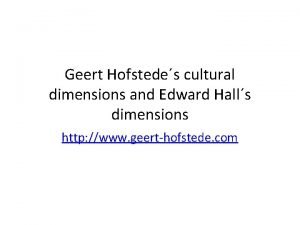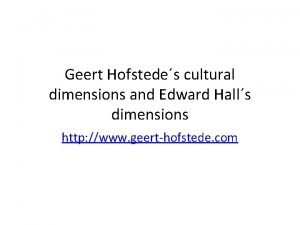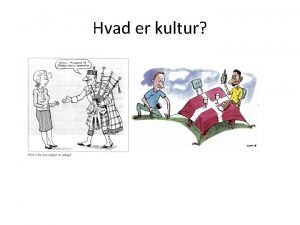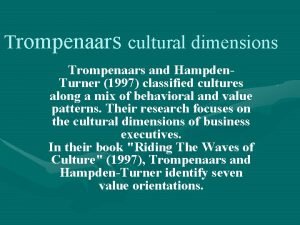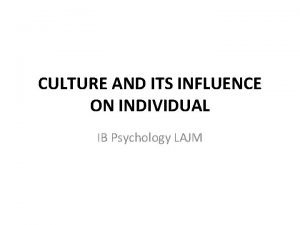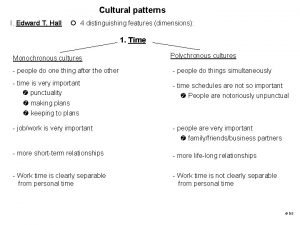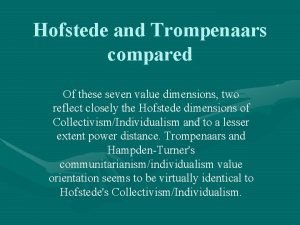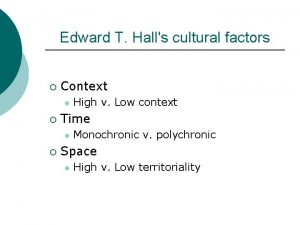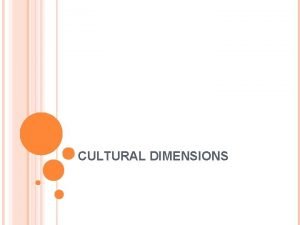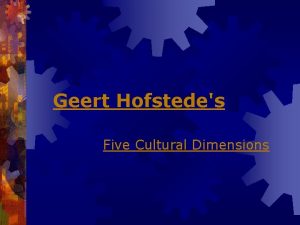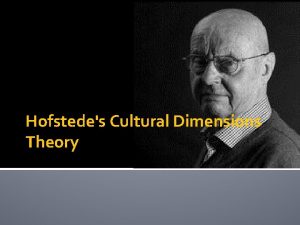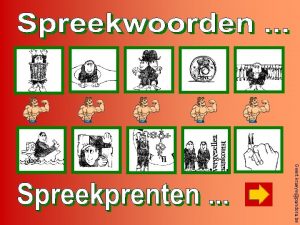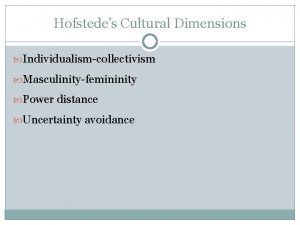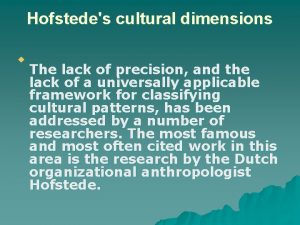Culture Two Paradigms Geert Hofstedes Cultural Dimensions The














- Slides: 14

Culture: Two Paradigms Geert Hofstede’s Cultural Dimensions (The essentialist view) This suggests that ‘culture’ is a concrete social phenomenon which represents the essential character of a particular nation. Adrian Holliday’s Small Cultures (The non-essentialist view) This suggests that ‘culture’ is a movable concept used by different people at different times to suit purposes of identity, politics and science.

Essentialist view of Culture Essentialism is the view that, for any specific entity (such as an animal, a group of people, a physical object, a concept), there is a set of attributes which are necessary to its identity and function. [1] In Western thought the concept is found as early as the work of. Plato and Aristotle: Platonic idealism is the earliest known theory of how all known things and concepts have an essential reality behind them (an"Idea" or "Form"), an essence that makes those things and concepts what they are. Personality Is specific to an individual Inherited/Learned Culture Specific to a group or category Learned Human Nature Universal Inherited

Culture seen as an onion Values Rituals Heroes Symbols Pr ac tic e s

Symbols The most superficial level of culture

Heroes • People alive, dead or imaginary who posses characteristics which are highly prized in a culture • Can serve as models for behaviour

Rituals Collective activities –technically, superfluous in reaching desired ends but socially essential

Values • • • At the core of cultural differences The first things children learn These are not consciously learned but implicit By the age of 10 most have a basic value system in place Because we learn them early they remain unconscious, are never discussed or observable, and are extremely difficult to unlearn.

Hofstede’s Essentialist Cultural Dimensions //geert-hofstede. com/dimensions. html Power Distance Index (PDI) Individualism (IDV) Long-Term Orientation (LTO) Masculinity (MAS) Uncertainty Avoidance Index (UAI)

Non-Essensionalist Culture is something that flows and shifts between us. It both binds us and separates us, but in different ways at different times and in different circumstances. There are many aspects of our behaviour which are ‘culturally different’. We must however be wary not to use these differences to feed conceptions of what certain national or ethnic groups can or cannot do – not to view them as exotic, simple, traditional ‘Others’ to our complex, modern selves.

The descriptions of individualism and collectivism Otherisation Individualism (us) autonomous, personal goals and attitudes, individual actions, linear progression, personal improvement, achievement and dominance, being assertive, aggressive, consistent, open to new experiences, self-reliance, having fun and equal distribution of resources, many choices North Americans of European backgrounds, North and West Europeans, Australians, New Zealanders. Collectivism (them) group loyalty and interdependence, stability, circular thinking, face derived from the group, few choices, membership by right of birth or marriage. Latin Americans, Southern Europeans, East and South Asians, Africans (Triandis 2004: x-xi)

Cultural imagination She smiles and says don’t worry Teacher isn’t able to see how I really feel Understanding the ‘us’-‘them’ politics of how culture works in multicultural classroom They cannot write Deconstruct a Western-Centred mentality students are not thinking critically How I feel has nothing to do with an ‘individualismcollectivism’ picture Why don’t they tell me what to do? They don’t ask questions The Japanese are so quiet Get over ‘this isn’t how we do things’ Class has a hidden, emergent culture

Disciplines for seeing Put aside preconceptions and ready-made systems for understanding. Appreciate complexity of descriptions. Avoid over-generalizing from individual instances. Incorporate the unexpected and emergent. Seek a deeper understanding of the ideologies and discourses which ‘Other’. Accept that actions are too easily political and patronizing.

Discovering a classroom Culture at Aber Basic values of Western university culture Self-reliance, independence, equality, competition, hard work, personal control over the environment, controlled by time, future orientation, action orientation, informality and directness. Questions to ask to uncover the culture of this class Is there great respect for the teacher in the classroom Would the teacher ever be challenged? Is group work encouraged? Is there mutual respect for students Are students expected to be modest and polite? Are students expected to participate in discussions? How traditional is the classroom? How important is conformity to rules? What is the attitude to other cultures? How formally do your colleagues and teachers dress? How competitive and assertive are your teachers/students? How direct is the communication with teachers? Is negotiation valued? How is criticism handled? What are attitudes towards plagiarism and cheating? What are the basic values of this class? What makes this classroom a ‘culture’?

References Baumann G. 1996. Contesting Culture. Cambridge: Cambridge University Press Hofstede G. 1991. Cultures and Organisations: software of the mind. Maidenhead: Mc. Graw-Hill Holliday A R. 1997. The politics of participation in international English language education. System 25/3 Holliday A R 1998. Japanese fragments. Unpublished paper, Canterbury Christ Church University College Holliday A R. 1999 Small cultures Applied Linguistics 20/2 Said, Edward W. 1978. Orientalism. 25 th Anniversary Edition. New York: Pantheon Books, 202. Print.
 Geert hofstedes
Geert hofstedes Geert hofstedes
Geert hofstedes Hofstedes løgdiagram
Hofstedes løgdiagram Magtdistance
Magtdistance Anerkendelsesbehov
Anerkendelsesbehov Trompenaars and hampden-turner cultural dimensions
Trompenaars and hampden-turner cultural dimensions Odden & rochat (2004)
Odden & rochat (2004) Edward t hall cultural dimensions
Edward t hall cultural dimensions Difference between hofstede and trompenaars
Difference between hofstede and trompenaars Hall cultural dimensions
Hall cultural dimensions Trompenaars seven dimensions of culture
Trompenaars seven dimensions of culture 7d cultural dimensions model
7d cultural dimensions model Five cultural dimensions
Five cultural dimensions Film outsourced
Film outsourced Gerard hendrik hofstede
Gerard hendrik hofstede
